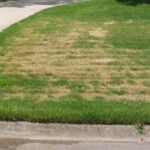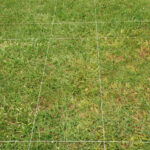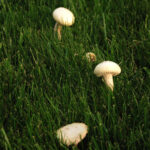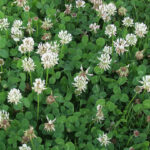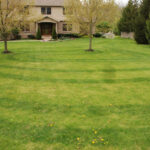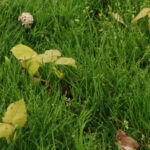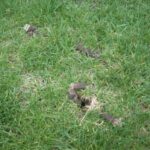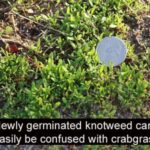Turf Tips Archives
Believe it or not, drought symptoms appearing in turf
With no rain in Indiana last week (5/17-23) followed by extremely erratic and spotty rain this week (5/24-30), drought symptoms are starting to show up near sidewalks and driveways and in other hotspots like south-facing slopes, compacted soils, and fairly new sod laid over compacted soils. Symptoms are typical drought stress starting out with a […]
Rhizoctonia Spring Patches
Brown Ring Patch Brown ring patch is a disease of annual bluegrass on putting greens. Damage is largely cosmetic, although in some areas smoothness and uniformity of putting surfaces are disturbed, warranting chemical control. The duration of symptom expression usually is brief (one or two weeks), and coincides with mild weather with ample moisture. Despite […]
Southern IN: Controlling common lespedeza (Lespedeza striata)
A common concern in southern Indiana lawns is common lespedeza, which is a summer annual spreading by wiry stems from a single taproot forming almost a mat in thin turf or next to sidewalk. The most common broadleaf herbicide is 2,4-D, but this is completely ineffective against lespedeza. A recent report from John Boyd at […]
Dallisgrass healthy in southern IN
Dallisgrass has reemerged and is very healthy with the rain and warming temperatures. Dallisgrass is often mistaken for crabgrass but typical preemergence or post emergence crabgrass herbicides do not work on dallisgrass. MSMA is currently the standard control but that herbicide will not be available after 2010. Our current research is focusing on Syngenta’s Tenacity […]
Effects of wet spring on turf
With the well-above average rainfall this spring, questions are starting to arise about the short and long term effects on lawn, golf, and sports turf: Rooting-Though no official records are kept, rooting tends to be shallow and limited on water-logged soils because of a lack of oxygen. Effects of a wet spring like this spring […]
White Clover in Golf Courses, Sports Turf, and Lawns
The small white flowers of white clover are very visible right now and it may appear that clover is taking over, especially under-fertilized turf areas. Clover is a legume and is very competitive under low N conditions, so increasing annual N is best method to help exclude this weed. However, its spreading stolons make it […]
Changing soil pH under turf
Soil testing is important in turf to help determine the soil pH and fertilization needs, especially for potassium and phosphorus. Acceptable soil pH for turf is between 6.0 and 7.5, but often soil tests show pH levels higher or lower than this. pH higher than 7.5: Some firms will recommend applying sulfur to reduce the […]
Responsible fertilization of home lawns
A properly fertilized turf has fewer weeds, is more resistant to insects and disease, and decreases water runoff compared to malnourished turf. Concern over the negative effects of nutrient enrichment on water quality is a growing public concern and has led many to start to question turfgrass fertilization practices. Although both nitrogen and phosphorus may […]
Volunteer tree seedlings in lawns?
I’ve gotten a number of calls asking about volunteer maple and other tree seedlings growing in lawns. These are direct descendents of a neighborhood tree whose seed pods released last spring/summer. You can either stake a couple of these small trees and nurture them over time to become a formidable maples, or you can control […]
Yellow Patch Is Active!
Yellow patch, also referred to as cool season brown patch, is caused by Rhizoctonia cerealis, a fungus closely related to the pathogens that cause brown patch and the Rhizoctonia large patch of zoysia grass. Although symptoms can be striking, yellow patch causes only cosmetic damage and does not affect playability. It occurs most often on creeping […]
Spring Lawn Aerification
Aerification, sometimes called core cultivation is a supplementary lawn cultural practice primarily used to relieve soil compaction and remove thatch (the spongy layer of undecomposed stems at the soil surface). This practices is not necessarily essential to maintaining a lawn, however, it can be very beneficial to most turf areas. In addition, to the aforementioned […]
Gypsum as a soil amendment? Probably not
Garden centers often advertise applying gypsum to your lawn to “decompact” the soil by improving the structure of clay soil. This only works in soils common in the arid western US where there is much more sodium than calcium in the soil. This does not work in Indiana because the parent material for most of […]
Seeding into areas where preemergence herbicide was applied this spring
A fairly typical question now is, ”Can I seed into an area where preemergence herbicide was applied earlier this spring”. The answer is a very simple “No”. These herbicides are active in the soil for up to 120 days and their nature is to be absorbed into the root of a germinating weed (or turfgrass […]
Season-long Grub Control Advertisements
Grub control products are currently being displayed in the center aisles of retail department and discount stores and are advertised on the radio as providing season-long grub control when applied in early May. What are the facts behind this recommendation? While certain grub control products do have a very long residual in the soil, they […]
Professionals Only: Spring Dandelion Control
Though fall applications are most effective for controlling broadleaf weeds, spring applications are warranted for new customers or areas that did not get treated last fall. Spring applications will be most effective if you wait until dandelions are at or near flowering, but still not as effective as fall applications. Applications before mid-April will only […]
Dandelions: Friend or Foe?
The annual bloom of dandelions is already here in southern Indiana and just around the corner in the rest of the state. Though some find dandelions attractive and some may actually eat them in salads or wine, others consider dandelions as weeds and try to control them in a lawn. The optimum time to control […]
Spacing between passes with a rotary spreader
Rotary spreaders are widely used by homeowners and professionals for most applying fertilizers and pesticides. So to test your knowledge, here’s a question that I constantly ask of professionals and do-it-yourselfers when spreading fertilizer back and forth on a turf area: A. Your current pass should spread product so it just touches the edge of the […]
Knotweed germinating next to sidewalks and other hotspots
Prostrate knotweed is currently germinating in thin areas next to sidewalks, cart paths, driveways and other hotspots. Knotweed is often confused with crabgrass at this early stage. Knotweed leaves have rounded leaf tips whereas crabgrass has leaf tips that come to a dull point (See photos). Crabgrass also has veins running lengthwise (parallel veination) whereas […]
Purdue Turfgrass Research Report Available On-Line
The summary of our turfgrass research in the year 2008 is now available at www.agry.purdue.edu/turf/report/2008/index.html. The overall goal of our research program is to minimize inputs while maintaining turf quality, minimizing costs, and further protecting our environment. Our research summary contains over 20 reports of on-going research at Purdue University . The report is a cooperative […]
For professionals only: Poa annua seedheads
Poa annua seedheads are just around the corner in most of Indiana and it’s high time to apply Embark or Proxy/Primo for seedhead reduction on golf courses. The seedhead models on our GDD Tracker at http://www.gddtracker.net indicate most of Indiana should be applying now. Embark and Proxy/Primo can effectively reduce seedheads of Poa annua, which tends to allow the Poa to […]
